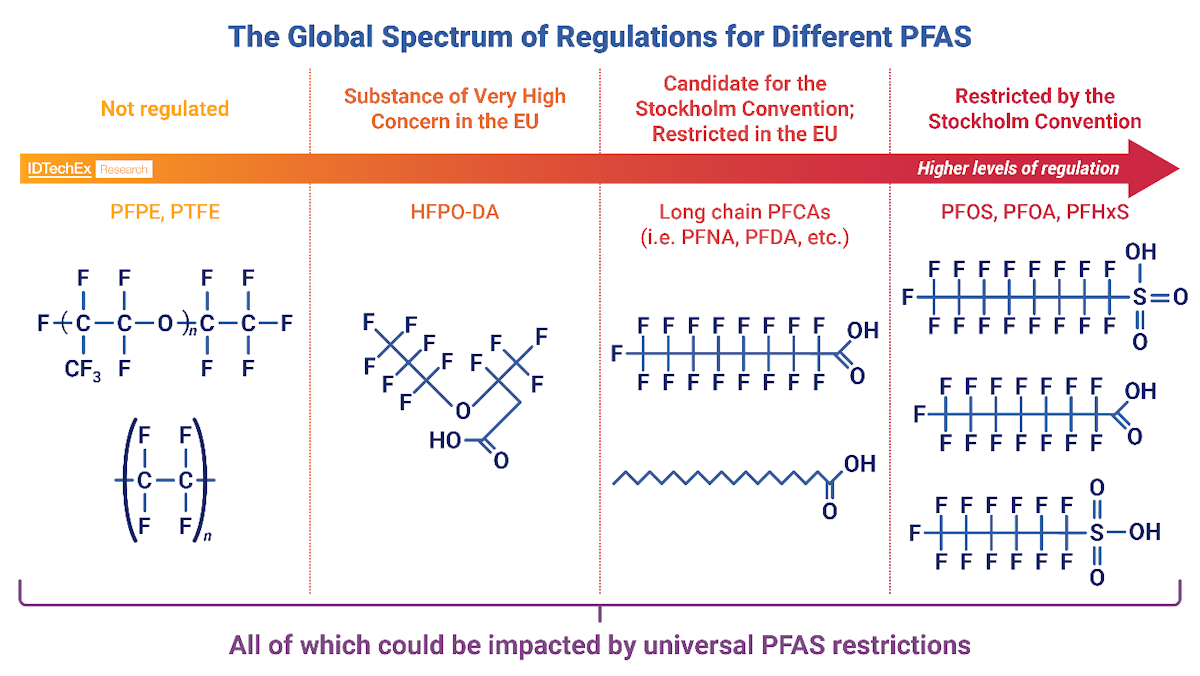Which High-Tech Industries Need to Find Alternatives for PFAS?
Mar 25, 2024
Sona Dadhania

"Forever chemicals", or PFAS, are coming under increasing regulatory pressure globally as concerns over the negative effects of PFAS on human health and the environment are mounting. In their brand new report, "Per- and Polyfluoroalkyl Substances (PFAS) 2024: Emerging Applications, Alternatives, Regulations", IDTechEx dives deeply to explore the future trajectory of PFAS in five key emerging applications: thermal management for data centers, sustainable food packaging, electric vehicles, low-loss materials for 5G, and the hydrogen economy.
Introducing the "forever chemical" family - PFAS
PFAS stands for per- and polyfluoroalkyl substances and refers to synthetic chemical compounds that contain multiple fluorine atoms attached to an alkyl chain. The broad definition of PFAS by the Organization of Economic Cooperation and Development encompasses nearly 5,000 unique chemicals, including PFOA, PFOS, and PTFE.
Unsurprisingly, the applications of different PFAS chemicals are nearly as broad as the chemical family itself. Depending on the specific chemical, PFAS are used in industries including semiconductor manufacturing, healthcare, non-stick cookware, and firefighting foams.
Why are concerns over PFAS rising?
Why are PFAS now coming under increased scrutiny? The colloquialism "forever chemicals" hints at a key issue for PFAS: its persistence in humans, wildlife, and the environment. Not only is PFAS persistent, but they can also be found even in isolated areas; thus, humans can be exposed to PFAS through a variety of sources. Now, scientific evidence is growing that, depending on different factors, continued exposure to specific PFAS may lead to negative health effects, such as increased risk of cancer, developmental delays, and hormonal issues (per the US EPA and the OECD).
A new regulatory landscape changing the trajectory of PFAS
With growing concerns over the impact of PFAS on human health and the environment, there are pushes for increased regulations on the use of certain groups of PFAS. Several important regions in the global economy are considering or adopting universal PFAS restrictions, including the European Union (which introduced its universal PFAS restriction proposal in 2023) and the US states of Maine and Minnesota. With such a complicated landscape of PFAS regulations potentially developing worldwide, it is essential for businesses to understand existing and proposed regulations for PFAS to understand its potential effect on them.

The global spectrum of regulations for different PFAS. Source: IDTechEx
Alternatives for PFAS in emerging high-tech applications: a critical consideration
As such, with broad legislation potentially impacting PFAS in countless different applications, it is essential for businesses to consider potential alternatives for PFAS.
Heavy regulations on PFAS would be particularly impactful in emerging high-tech applications. In these less-established markets, PFAS can sometimes act as key technology enablers. PFAS could be used as membranes in fuel cells, as coolants for immersion cooling in data centers, as insulating materials in high-voltage cables, or as moisture-repelling coatings in molded fiber packaging. Therefore, identifying replacements for PFAS in those applications will be important for the future growth of those emerging areas.
For businesses manufacturing or using PFAS in high-tech fields, IDTechEx's new report, "Per- and Polyfluoroalkyl Substances (PFAS) 2024: Emerging Applications, Alternatives, Regulations", not only identifies the specific impact of different PFAS regulations in key emerging application areas but also identifies potential alternatives for PFAS in these areas. Covering a broad range of growing yet critical future markets, the five main emerging technology areas analyzed by IDTechEx are:
- Membranes in the hydrogen economy
- Thermal management for data centers
- Electric vehicles
- Low-loss materials for 5G
- Sustainable food packaging
There are many alternatives that could potentially replace PFAS in these emerging applications. These alternatives may be at different stages of technology readiness and market maturity, but by analyzing their status, suppliers, advantages, disadvantages, etc., a critical assessment of these non-PFAS alternatives' market potential can be developed. Some alternatives have the potential to substantially impact their application areas, while others have a much longer road to market penetration that includes solving major technical and economic challenges. Regardless, for anyone connected to emerging industries, the pressure is increasing to have a clear understanding of how future PFAS regulations may impact nascent high-tech industries but also what commercial and developing alternative materials are available to replace PFAS in these industries.
For more information on the new IDTechEx report "Per- and Polyfluoroalkyl Substances (PFAS) 2024: Emerging Applications, Alternatives, Regulations", including downloadable sample pages, please visit www.IDTechEx.com/PFAS.
For the full portfolio of sustainability market research from IDTechEx, please visit www.IDTechEx.com/Research/Sustainability.
IDTechEx provides trusted independent research on emerging technologies and their markets. Since 1999, we have been helping our clients to understand new technologies, their supply chains, market requirements, opportunities and forecasts. For more information, contact research@IDTechEx.com or visit www.IDTechEx.com.